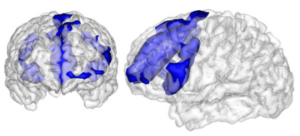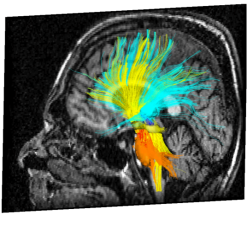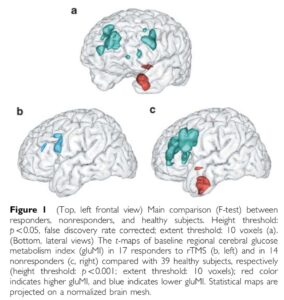The team highlighted the changes in brain function under the effect of the treatments, and according to the response or resistance of the patients.
At the level of the cortex
The first step was to show functional anomalies in the frontal cortex of patients with depression resistant to antidepressant treatment.
Decreased frontal energy metabolism measured by positron emission tomography with fluorodesoxiglucose in a group of treatment-resistant depressed patients.
The second step was to compare the measurements of the sulci of the cerebral hemispheres between bipolar patients in remission and those resistant to treatment.
A statistical reduction in sulcus area was detected in treatment-resistant patients compared to healthy subjects, while no abnormality was found in treatment-responsive patients.
These results motivated the implementation of an innovative therapeutic trial using transcranial magnetic stimulation guided to the dysfunctional regions.
In bipolar patients in remission, responding to treatment, changes were detected in :
– the microstructure of the white matter :
- Particularities of the uncinate bundle that connects the inner cingulate and temporal regions (Molecular Psychiatry 2007). These paralimbic regions are involved in emotional regulation.
- Changes in the anisotropy of frontal and cingulate regions (Bipolar Disorder 2009).
- of brain function: hyperactivation of orbitofrontal, cingulate, insula and caudate nuclei detected in functional MRI in these same patients during emotional stimuli (American Journal of Psychiatry 2007).
CONTRIBUTION OF THIS WORK
In mood disorders, the evidence of anatomical and functional changes raises the question of the relationship between variations in brain structure and :
- psychopathological vulnerability
- resistance to the usual therapies
Research prospects :
- markers of response or resistance to treatment, adaptation of therapeutic strategies to patient subgroups
- vulnerability factors in adolescents, preventive interventions
These results have motivated the implementation of an innovative therapeutic trial using transcranial magnetic stimulation guided towards the dysfunctional regions.
https://www.ncbi.nlm.nih.gov/pmc/articles/PMC3230494/pdf/npp2011161a.pdf


